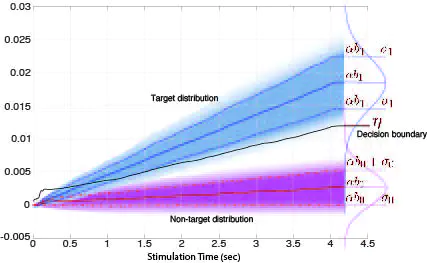Bayesian dynamic stopping for BCI

Context
Many conventional BCI systems adhere to fixed trial lengths. This allows users to issue commands only at predetermined intervals and using a constant amount of EEG data. Various more sophisticated methods have emerged to optimize trial duration dynamically, taking into account the non-stationary data.
Dynamic stopping methods enhance BCI system speed by deciding at any moment whether to output a classification or wait for more information. Such approach uses trial variance, allowing good trials to be detected earlier, thereby speeding up the process without significantly compromising accuracy.
Existing dynamic stopping algorithms typically optimize measures such as symbols per minute (SPM) and information transfer rate (ITR). However, these metrics may not accurately reflect system performance for specific applications or user types. Moreover, many methods depend on arbitrary thresholds or parameters that require extensive training data.
To tacle these challenges, we developed a model-based approach that takes advantage of the analytical knowledge that we have about the underlying classification model. By using a risk minimization approach, our model allows precise control over the types of errors and the balance between precision and speed. The risk minimization is performed through optimizing Bayes criterion and therefore we call the method Bayesian dynamic stopping (BDS).
So far, the method has been developed and tested on c-VEP data. There are various interesting directions to investigate and further optimize and validate this method.
Image credit: Ahmadi, S., Desain, P., & Thielen, J. (2024). A Bayesian dynamic stopping method for evoked response brain-computer interfacing. Frontiers in Human Neuroscience, 18, 1437965.
Research question
As part of this project, you will dive into one of the following topics:
-
A validation of other BCI paradigms. So far, we validated BDS only on an existing c-VEP dataset. However, we strongly believe that BDS can be applied to any BCI protocol. You will implement and validate BDS on either an ERP, SSVEP, or other dataset.
-
A comparison of existing early stopping methods. So far, we compared BDS to a handful of other methods. Comparison to other methods could reveal strengths and weaknesses of methods, and could inspire further improvement. You will implement and compare these other methods.
-
Translation to an online experiment. So far, we evaluated BDS on an existing dataset. To show the capabilities of the method, we should however evaluate it in a real-time experiment as well. You will implement about two BCI applications that use BDS.
Literature
The original BDS publication:
- Ahmadi, S., Desain, P., & Thielen, J. (2024). A Bayesian dynamic stopping method for evoked response brain-computer interfacing. Frontiers in Human Neuroscience, 18, 1437965. DOI: https://doi.org/10.3389/fnhum.2024.1437965
Skills / background required
- Knowledge and an interest in brain-computer interfacing
- Very proficient in Python